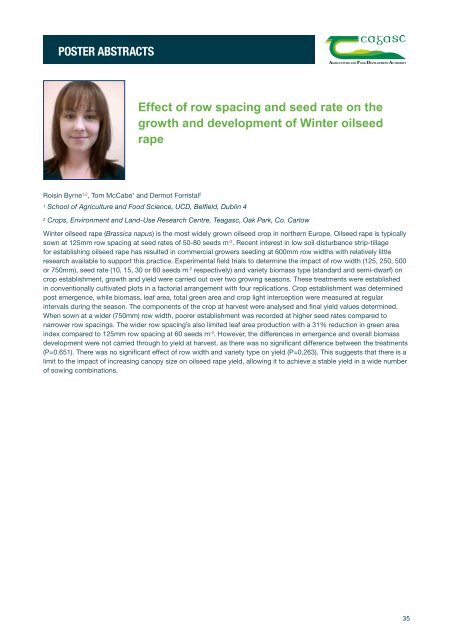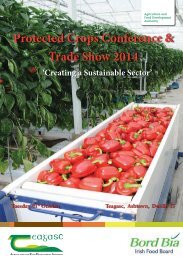FellowshipS Seminar 2016
2fFF9y9
2fFF9y9
Create successful ePaper yourself
Turn your PDF publications into a flip-book with our unique Google optimized e-Paper software.
Poster ABSTRACTS<br />
Effect of row spacing and seed rate on the<br />
growth and development of Winter oilseed<br />
rape<br />
Roisin Byrne 1,2 , Tom McCabe 1 and Dermot Forristal 2<br />
1 School of Agriculture and Food Science, UCD, Belfield, Dublin 4<br />
2 Crops, Environment and Land-Use Research Centre, Teagasc, Oak Park, Co. Carlow<br />
Winter oilseed rape (Brassica napus) is the most widely grown oilseed crop in northern Europe. Oilseed rape is typically<br />
sown at 125mm row spacing at seed rates of 50-80 seeds m -2 . Recent interest in low soil disturbance strip-tillage<br />
for establishing oilseed rape has resulted in commercial growers seeding at 600mm row widths with relatively little<br />
research available to support this practice. Experimental field trials to determine the impact of row width (125, 250, 500<br />
or 750mm), seed rate (10, 15, 30 or 60 seeds m -2 respectively) and variety biomass type (standard and semi-dwarf) on<br />
crop establishment, growth and yield were carried out over two growing seasons. These treatments were established<br />
in conventionally cultivated plots in a factorial arrangement with four replications. Crop establishment was determined<br />
post emergence, while biomass, leaf area, total green area and crop light interception were measured at regular<br />
intervals during the season. The components of the crop at harvest were analysed and final yield values determined.<br />
When sown at a wider (750mm) row width, poorer establishment was recorded at higher seed rates compared to<br />
narrower row spacings. The wider row spacing’s also limited leaf area production with a 31% reduction in green area<br />
index compared to 125mm row spacing at 60 seeds m -2 . However, the differences in emergence and overall biomass<br />
development were not carried through to yield at harvest, as there was no significant difference between the treatments<br />
(P=0.651). There was no significant effect of row width and variety type on yield (P=0.263). This suggests that there is a<br />
limit to the impact of increasing canopy size on oilseed rape yield, allowing it to achieve a stable yield in a wide number<br />
of sowing combinations.<br />
35




